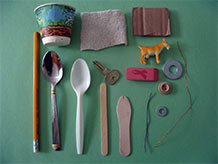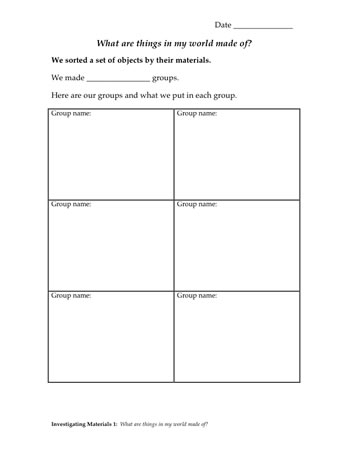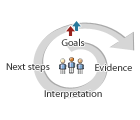What are things in my world made of?
Plan Investigating Materials 1
Scissors … windows … lunch boxes … sneakers. These are the kinds of objects that children see every day. They give them more attention than you might realize, and they have a lot of ideas about them – what they're made of, how they work, what they're worth.
Formative Assessment
Can students distinguish between objects and the materials they are made of?
Available online at inquiryproject.terc.edu
In this investigation, you will explore some of your students' ideas about what things are made of and how different materials behave. You will help them distinguish between “objects” and "materials," and you will help them identify different kinds of materials, such as metal, plastic, and wood.
Students will first explore a collection of everyday objects that you supply, including a paperclip, a pencil, a popsicle stick and a key. Then they will sort these objects into groups according to their materials. Students will also explore the classroom to notice additional objects and the materials from which they are made.
By the end of the investigation, the children will be looking around the classroom with the eyes of a scientist, wondering about the materials objects are made of.
Learning Goals
- to distinguish between an object (e.g., a key) and the material it is made of (e.g., metal)
- to understand that some objects (e.g., spoons) can be made of different materials (e.g., wood, metal, and plastic) and that some objects are made of more than one material (e.g., pencils)
- to observe and record details
| Sequence of experiences | ||
|---|---|---|
| 1. Ask the question | Discussion | 15 Mins |
| 2. Sort objects by materials | Small Groups | 15 Mins |
| 3. Make meaning | All Class | 10 Mins |
| 4. Find a personal object | All Class | 5 Mins |
Materials and Preparation

- Post the investigation question in a place where all students can see it.
- Post the following title on a whiteboard or flip chart: “Materials and What We Know About Them.”
- Set aside a separate set of materials for group discussion.
- piece of cardboard, approx 2"x2"
- plastic-covered copper wire,approx 6" long
- bare copper wire; approx 6" long
- piece cotton cloth fabric, approx 2"x2"
- wooden spoon (ice cream type)
- metal spoon
- plastic spoon
- metal key
- steel bolt
- 3-oz paper cup
- rubber eraser
- plastic counting bear
- steel washer
- wooden coffee stirrer
- pencil
Notebook Pages
Can students distinguish between objects and the materials they are made of?
Observe students as they work in groups and listen to their small group discussion. Look and listen for evidence that they can distinguish objects from the materials they are made of.
Use these criteria to interpret students' work:
- Do they create sorting categories based on kind of material (metal, plastic, wood products, rubber) and not objects (spoons)?
- Is there a group for every object?
- Do students recognize that some objects made of more than 1 material (covered wire, pencil) and how do they deal with these? (stretch across groups, create category called "more than 1 material")
Your next step might create a new set of sorting categories for the same collection of items students used; ask students to use a stickie note to "agree" or "disagree" with your sorting scheme and explain their reasoning.






